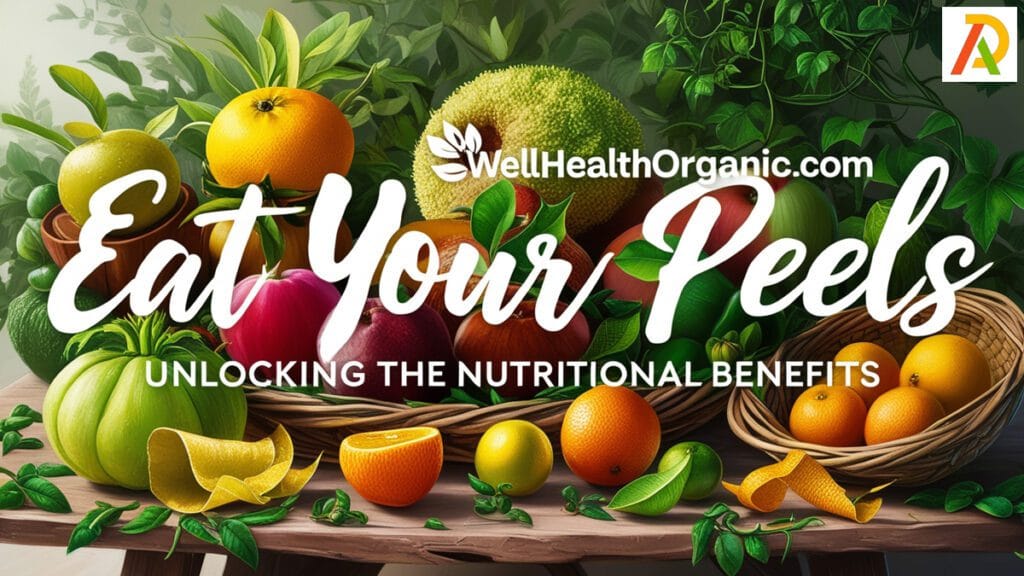Wellhealthorganic.com : Eat Your Peels: Unlocking the Nutritional Benefits

Do you have the habit of throwing peels when eating fruits? When you peel an apple, potato, or cucumber, you might not realize you’re discarding some of the most nutritious parts of the food. Fruit and vegetable peels contain essential vitamins, fiber, and antioxidants, providing numerous health benefits. Today, let me explain why Wellhealthorganic.com : Eat Your Peels: Unlocking the Nutritional Benefits is a practice worth adopting. We’ll explore the science behind eating peels, their impact on health, how to use them safely, and eco-friendly ways to reduce waste.
Research suggests that peels can help improve digestion, support heart health, boost immunity, and even aid in weight loss. Yet, millions of tons of peels end up in the trash every year, contributing to unnecessary food waste.
Nutritional Benefits of Eating Peels
Peels aren’t just an outer layer; they’re a powerhouse of essential nutrients that support overall health. Let’s break down their key benefits.
1. High in Fiber for Digestive Health
Fiber is a crucial component of a healthy diet; most peels are packed with it. Dietary fiber aids digestion, prevents constipation, and supports gut health. Apple peels contain soluble and insoluble fiber, promoting smoother digestion and reducing the risk of colon diseases.
Potato peels have resistant starch, which acts as a prebiotic and feeds beneficial gut bacteria. Cucumber and carrot peels provide roughage that aids in bowel movement and detoxification. Eating peels increases your fiber intake naturally, which also helps regulate blood sugar levels and cholesterol.
2. Rich in Antioxidants That Fight Free Radicals
Antioxidants protect cells from oxidative stress linked to aging, inflammation, and chronic diseases. Peels are one of the richest sources of antioxidants in nature. Citrus peels contain flavonoids like hesperidin and naringin, which reduce inflammation and support cardiovascular health.
Potato peels are high in polyphenols, which help fight free radicals and improve skin health. Grape and pomegranate peels contain resveratrol, known for its anti-aging and heart-protective properties. Consuming peels enhances your body’s defense system against environmental toxins and pollutants.
3. Packed with Essential Vitamins and Minerals
Many peels have higher concentrations of nutrients than the inner flesh of fruits and vegetables. Banana peels are rich in potassium and magnesium, vital for muscle function and heart health. Carrot peels contain beta-carotene, which converts into vitamin A, supporting vision and immune health.
Cucumber peels are a source of silica, a mineral essential for strong hair, nails, and skin elasticity. Eating peels ensures you receive the full spectrum of vitamins and minerals present in produce.
4. Aids in Weight Loss and Metabolism
Peels help with weight management due to their fiber content and low-calorie density. Fiber keeps you full longer, reducing hunger cravings and overeating. They promote fat metabolism by aiding digestion and improving gut microbiota balance. Citrus peels contain pectin, which supports healthy blood sugar levels and prevents insulin spikes. Incorporating peels into your diet is a great step if you’re looking for an easy and natural way to maintain a healthy weight.
5. Supports Heart Health
A diet rich in fiber and antioxidants from peels reduces the risk of heart disease. Apple peels contain polyphenols that lower bad cholesterol (LDL) and prevent artery blockage. Citrus peels contain compounds that enhance blood circulation and reduce hypertension.
Pomegranate peels have anti-inflammatory effects that reduce the risk of cardiovascular diseases. Regularly eating peels protects your heart and improves overall cardiovascular health.
Read more articles on health & wellness
- Organic food for pets
- Natural beauty tips for radiant skin
- Neem and aloe vera juice benefits
- Tips for healthy lifestyle
Best Fruit and Vegetable Peels to Eat
Not all peels are edible, but many are safe and highly nutritious. Here’s a list of peels you should consider adding to your diet:
1. Apple Peels
- Contain quercetin, which reduces inflammation.
- Improve brain function and memory.
- Used in smoothies, teas, and baked dishes.
2. Banana Peels
- Rich in tryptophan, a precursor to serotonin, which boosts mood.
- Support better sleep and stress reduction.
- Can be used in stir-fries, smoothies, and herbal teas.
3. Citrus Peels (Lemon, Orange, Lime)
- Loaded with vitamin C, flavonoids, and pectin.
- Help in digestion and immune support.
- Used in teas, zest, marmalades, and marinades.
4. Potato Peels
- Contain iron and vitamin B6, which support brain function.
- Used in baked chips, soups, and vegetable broths.
5. Cucumber Peels
- Have hydrating properties and support healthy skin.
- Used in salads, smoothies, and sandwiches.
6. Carrot Peels
- Enhance vision and immune response.
- Can be added to soups, stir-fries, and stocks.
How to Eat Peels Safely
Before consuming peels, ensure they are free from harmful pesticides and chemicals.
1. Wash and Scrub Thoroughly
- Rinse under cold running water.
- Use a baking soda or vinegar soak to remove pesticide residues.
2. Choose Organic Produce When Possible
- Organic fruits and vegetables have fewer chemical residues.
3. Cook Peels for Better Flavor
- Roasting, stir-frying, or boiling peels reduces bitterness and enhances nutrients.
4. Avoid Toxic Peels
- Do not eat avocado, lychee, or pineapple peels, as they can be toxic or hard to digest.
Eco-Friendly Benefits of Eating Peels
Eating peels isn’t just beneficial for health and reduces food waste and promotes sustainability.
- 1.3 billion tons of food are wasted globally annually—eating peels helps minimize waste.
- Peels can be used in composting or natural home remedies.
- Reducing waste lowers environmental impact and promotes a sustainable lifestyle.
- Using peels saves money, reduces landfill waste, and supports an eco-friendly lifestyle.
FAQ Section
1. Are all fruit and vegetable peels edible?
No, peels like avocado, lychee, and pineapple can be toxic or too tough to digest. Stick to apple, citrus, and potato peels.
2. How do I clean fruit and vegetable peels?
Wash under running water and soak in a baking soda or vinegar solution for at least 10 minutes.
3. Can I eat banana peels raw?
Yes, but they taste better boiled, blended in smoothies, or stir-fried.
4. What is the best way to store peels?
Keep them refrigerated in an airtight container or dry them for future use.
Start incorporating peels into your meals today and unlock the full potential of your fruits and vegetables!
Conclusion: Start Eating Peels for a Healthier Life
Wellhealthorganic.com : Eat Your Peels: Unlocking the Nutritional Benefits highlights the overlooked power of fruit and vegetable peels. They are rich in fiber, antioxidants, and essential nutrients, making them a simple yet powerful addition to your diet. Eating peels supports digestive health, enhances immunity, manages weight, and contributes to a more sustainable planet. Next time you grab an apple, banana, or potato, think twice before peeling—it might be the most nutritious part!


